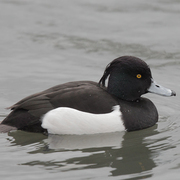Tufted Duck
General Description
The most frequently encountered of Washington’s rare waterfowl, Tufted Duck is a Eurasian member of a widely distributed genus of diving ducks that includes Greater and Lesser Scaups and Ring-necked Duck. The male in breeding plumage is told from these similar species by its solid black back and bright white sides with no vermiculation and by a tuft of plumes that hangs down from the rear of the crown (difficult to see when wet and plastered against the head, as it often is when the duck has been diving). The bill has a broad black tip with little or no white behind it. Tufted Duck females, juveniles, and non-breeding-plumaged males are more or less uniformly brown with a much smaller plume or none at all. They are easily confused with scaups and Ring-necked Ducks in similar plumages, and are best separated from them by subtle details of head and bill shape and markings. Hybrids—especially with Greater Scaup—further complicate field identification.
The Tufted Duck breeds at high and middle latitudes from Iceland eastward to Siberia and winters farther south in Europe, Africa, and Asia. Significant numbers reach North America in fall migration and spend the winter, mostly along the Atlantic and Pacific coasts. They are usually found as single birds associating with flocks of scaup or Ring-necked Ducks, often in city parks, and sometimes return for successive years. Washington has had about 50 records since the first one in Seattle (King County) in 1967, and Tufted Duck has been an almost annual visitor to the state since 1979, mostly west of the Cascades. There are now about 10 eastern Washington records, with the first from Wenatchee (Chelan County) in 1986. Oregon has had about 30 records since 1960, and Tufted Duck is annual in British Columbia. Three records have been accepted in Idaho.
Revised June 2007
Family Members
 Fulvous Whistling-DuckDendrocygna bicolor
Fulvous Whistling-DuckDendrocygna bicolor Taiga Bean-GooseAnser fabalis
Taiga Bean-GooseAnser fabalis Greater White-fronted GooseAnser albifrons
Greater White-fronted GooseAnser albifrons Emperor GooseChen canagica
Emperor GooseChen canagica Snow GooseChen caerulescens
Snow GooseChen caerulescens Ross's GooseChen rossii
Ross's GooseChen rossii BrantBranta bernicla
BrantBranta bernicla Cackling GooseBranta hutchinsii
Cackling GooseBranta hutchinsii Canada GooseBranta canadensis
Canada GooseBranta canadensis Mute SwanCygnus olor
Mute SwanCygnus olor Trumpeter SwanCygnus buccinator
Trumpeter SwanCygnus buccinator Tundra SwanCygnus columbianus
Tundra SwanCygnus columbianus Wood DuckAix sponsa
Wood DuckAix sponsa GadwallAnas strepera
GadwallAnas strepera Falcated DuckAnas falcata
Falcated DuckAnas falcata Eurasian WigeonAnas penelope
Eurasian WigeonAnas penelope American WigeonAnas americana
American WigeonAnas americana American Black DuckAnas rubripes
American Black DuckAnas rubripes MallardAnas platyrhynchos
MallardAnas platyrhynchos Blue-winged TealAnas discors
Blue-winged TealAnas discors Cinnamon TealAnas cyanoptera
Cinnamon TealAnas cyanoptera Northern ShovelerAnas clypeata
Northern ShovelerAnas clypeata Northern PintailAnas acuta
Northern PintailAnas acuta GarganeyAnas querquedula
GarganeyAnas querquedula Baikal TealAnas formosa
Baikal TealAnas formosa Green-winged TealAnas crecca
Green-winged TealAnas crecca CanvasbackAythya valisineria
CanvasbackAythya valisineria RedheadAythya americana
RedheadAythya americana Ring-necked DuckAythya collaris
Ring-necked DuckAythya collaris Tufted DuckAythya fuligula
Tufted DuckAythya fuligula Greater ScaupAythya marila
Greater ScaupAythya marila Lesser ScaupAythya affinis
Lesser ScaupAythya affinis Steller's EiderPolysticta stelleri
Steller's EiderPolysticta stelleri King EiderSomateria spectabilis
King EiderSomateria spectabilis Common EiderSomateria mollissima
Common EiderSomateria mollissima Harlequin DuckHistrionicus histrionicus
Harlequin DuckHistrionicus histrionicus Surf ScoterMelanitta perspicillata
Surf ScoterMelanitta perspicillata White-winged ScoterMelanitta fusca
White-winged ScoterMelanitta fusca Black ScoterMelanitta nigra
Black ScoterMelanitta nigra Long-tailed DuckClangula hyemalis
Long-tailed DuckClangula hyemalis BuffleheadBucephala albeola
BuffleheadBucephala albeola Common GoldeneyeBucephala clangula
Common GoldeneyeBucephala clangula Barrow's GoldeneyeBucephala islandica
Barrow's GoldeneyeBucephala islandica SmewMergellus albellus
SmewMergellus albellus Hooded MerganserLophodytes cucullatus
Hooded MerganserLophodytes cucullatus Common MerganserMergus merganser
Common MerganserMergus merganser Red-breasted MerganserMergus serrator
Red-breasted MerganserMergus serrator Ruddy DuckOxyura jamaicensis
Ruddy DuckOxyura jamaicensis

